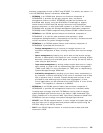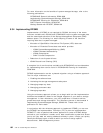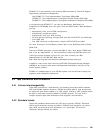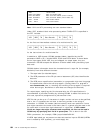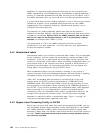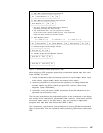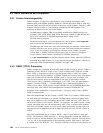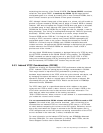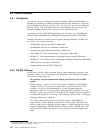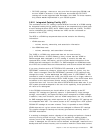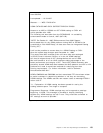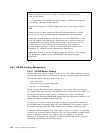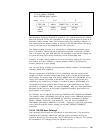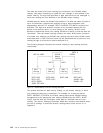maintaining the accuracy of the Format-5 DSCB.
The Format-5 DSCB
, sometimes
called the ″free space DSCB″,
is used only by OS/390
. OS/390 keeps track of
unallocated space on a volume by creating one or more Format-5 DSCBs; that is,
each Format-5 contains up to 26 extents of free space information.
VSE, although it doesn′t keep track of free space on a volume, will still be able to
process a volume created by OS/390 (and on which a Format-5 DSCB is located).
However, VSE does not update the Format-5 DSCB when new space is allocated,
or allocated space is freed. Although VSE ignores Format-5 DSCBs, it ″tells″
OS/390 that the Format-5 DSCBs may no longer be valid (for example, a new file
being allocated). This ″telling″ is accomplished through the ″DOS bit″ (previously
discussed). OS/390, when it first allocates to a volume, always checks the
Format-4 DSCB and the ″DOS bit.″ If it finds this bit ″on″, OS/390 creates (by
invoking a VTOC, conversion routine) new Format-5 DSCBs representing all
unallocated space it finds on the volume. Should there already be Format-5
DSCBs on a volume from prior OS/390 uses, OS/390 invalidates these and
creates new ones. (An appropriate OS/390 message is displayed on the operator
console whenever new Format-5 DSCBs are created as a result of VSE′s
previous use of the volume.)
You may obtain OS/390 dump, formatted, or abridged listings of a VTOC by using
the LISTVTOC command of the OS/390 IEHLIST utility program. The DFSMSdss
PRINT command can also be used to print all or part of the VTOC. A VTOC
listing can be obtained under VSE by executing the LVTOC utility program. In
both environments, DITTO/ESA′s DVT function may also be used.
5.5.3 Indexed VTOC Considerations (OS/390)
OS/390 has a facility for improved DASD VTOC performance called the Indexed
VTOC. Indexed VTOCs are optional but are strongly recommended in OS/390.
Their major benefit is improved VTOC performance by avoiding lengthy
hardware keyed searches of the VTOC, which tie up the channel and device, and
by managing free space information in such a way that the number of I/O
operations required to obtain or release space on the volume is reduced. We
recommend that you use indexed VTOCs. Details can be found in
DFSMSdfp
Advanced Services
, SC26-4921.
The VTOC index itself is a specialized data set which resides on the same
volume as the VTOC to which it refers. As such, it has a Format-1 DSCB in the
VTOC which contains the index′s data set name and extent information. The
index data set name must adhere to the naming convention
″SYS1.VTOCIX.xxxxxxxx″ where xxxxxxxx is user defined: It is recommended that
you include the volume′s serial number.
It is not recommended that OS/390 volumes with Indexed VTOCs be used on VSE
systems. If the need exists, care must be exercised - each volume has to be
converted from an Indexed VTOC to a non-indexed VTOC (that is, a VTOC with
no index) before transporting the volume to the VSE system. Otherwise, serious
errors may result when the volume is returned to the OS/390 system; that is,
VTOC changes made on the VSE system not causing reconstruction of the VTOC
are not recorded in the index and, in effect, invalidate the index.
For more information on the Indexed VTOC facility, see
DFSMSdfp Advanced
Services
, SC26-4921. For more information on creating Index VTOCs, see the
Device Support Facilities User
′
s Guide and Reference
.
Chapter 5. Disk and Tape Storage Considerations 109



